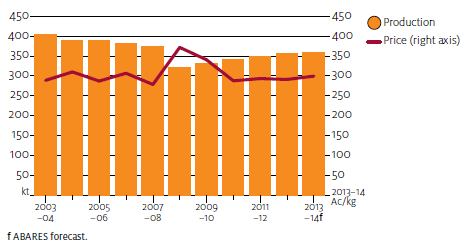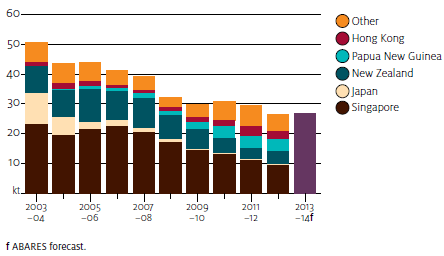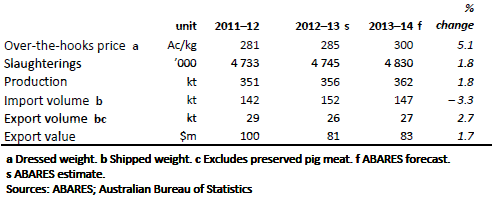



Australia: Agricultural Commodities: Pig Meat
A review of the state of the industry by Clay Mifsud, based on research by the Australian Bureau of Agricultural and Resource Economics and Sciences (ABARES) for the September Quarter 2013.The weighted average over-the-hooks price of pigs is forecast to increase by five per cent in 2013–14 to 300 cents a kilogram (dressed weight), due to the lower Australian dollar increasing import and export competitiveness. Domestic feed grain prices, which account for more than 50 per cent of production costs, are forecast to fall and will also help profitability for pig producers. This reflects lower world prices because of higher production in the northern hemisphere.

Production to Rise
In 2013–14, Australian pig meat production is forecast to increase by two per cent to 362,000 tonnes. Forecast lower prices of feed grains is expected to support greater retention of breeding sows and an increase in overall pig numbers as returns from production increase. The pig-to-wheat and pig-to-barley price ratios - indicators of returns from pig production - are expected to rise over the remainder of 2013–14.
In 2012–13, Australian pig meat production increased by 1.5 per cent to 356,000 tonnes, reflecting growth in average slaughter weights. The average pig slaughter weight increased by more than one per cent to a record 75kg, while the number of pigs slaughtered rose slightly from the previous year.

Lower Imports in 2013–14
Imports of pig meat in Australia increased three-fold over the 10 years to 2012–13, resulting in greater competition for manufacturers of Australian ham, bacon and small goods. Australia’s import policy for pig meat allows cooked and uncooked (for cooking upon arrival in Australia) deboned pig meat to be imported from approved countries subject to specific import conditions. Because of quarantine restrictions, all fresh pig meat sold in Australia is domestically produced.
Australian pig meat imports increased year-on-year by seven per cent in 2012–13 to 152,000 tonnes (shipped weight). Imports from the United States - the largest supplier - increased by six per cent to 62,000 tonnes, as lower US pig prices and a higher Australian dollar made US pig meat increasingly competitive with Australian pig meat in the processed pig meat market. The higher Australian dollar also contributed to growth in imports from Denmark and the Netherlands. The share of imports in Australian pig meat consumption rose by one percentage point to 49 per cent in 2012–13.

In 2013–14, Australian pig meat imports are forecast to fall by three per cent to 147,000 tonnes (shipped weight), reflecting a decline in the competitiveness of imports in the domestic processed pig meat market. The Australian dollar is assumed to average lower, making imports from North America and the European Union - where more than 98 per cent of Australia’s imports are sourced - more expensive in Australian dollar terms.

Exports to Rise Slightly in 2013–14
Australian pig meat exports fell by 11 per cent in 2012–13 to 26 000 tonnes (shipped weight), the lowest since 1998–99, reflecting increased competition in export destinations from other pig meat exporters.
Shipments to Singapore - Australia’s largest export market for pig meat - fell by 14 per cent to 9,000 tonnes as Singaporean imports of pig meat from the Netherlands and live pigs from Indonesia increased. Australian exports to most other markets in the Asia–Pacific region, including Papua New Guinea, Hong Kong and Malaysia, also declined in 2012–13.
Australian pig meat exports are forecast to increase by three per cent in 2013–14 to around 27,000 tonnes (shipped weight), with Singapore and New Zealand expected to remain the largest markets. The lower Australian dollar is likely to make Australian pig meat more price-competitive in export markets. However, pig meat exports are forecast to remain low relative to the 10-year average to 2012–13 of 37,000 tonnes.

Pig meat outlook

October 2013








